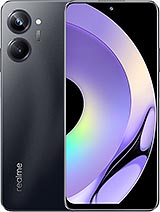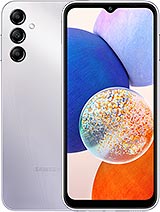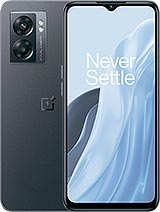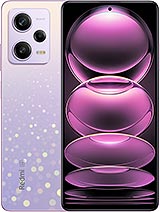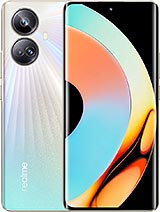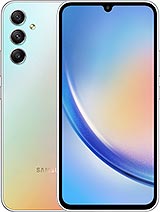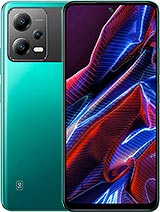OnePlus Nord N30 5G review

6.72-inch, 120Hz LCD
The Nord N30 5G has a 6.72-inch 2400x1800 resolution LCD. It is nothing special in particular, but it does operate at 120Hz. More on that in a bit. OnePlus says that the panel should be able to do around 550 nits in regular operation and boost to about 680 nits. We were mostly able to confirm these rough numbers. We measured 551 nits of brightness by maxing out the slider. The Nord N30 5G has a maximum auto brightness beyond that. It managed to boost output to 671 nits. Not quite what OnePlus advertises, but close enough.

Regardless, the Nord N30 5G is usable outdoors, even in sunlight, but not comfortably so. An LCD is never going to be as contrasty as an OLED. Still, this panel does OK in this regard. We measured a contrast of 1172:1.
OnePlus has never really bothered to color-calibrate its Nord devices too carefully, and the N30 5G is no exception. It has two color modes in settings - Vivid and Natural- and a color temperature slider that works with both modes. No custom white point adjustments are available.
Color accuracy is all over the place. The default vivid mode targets the DCI-P3 color space and mostly manages to cover it, though not particularly accurately. Blues are very boosted and way off. You can correct some of the image's coldness by going all the way to warm on the color temperature slider, but even that is not enough to get good color accuracy deltaE values. The same goes for the Natural color mode, which targets the sRGB color space and mostly falls short in the same manner with a blue tint on everything.
The Nord N30 5G has no HDR support on its display. In terms of HDR decoding, it can do HDR10 and HLG but not HDR10+ or Dolby Vision. On a more positive note, the phone has the highest possible Widevine L1 DRM certification, allowing services like Netflix to offer up FullHD streams and saturate its display resolution.



HDR decoder • DRM • Netflix playback capabilities
High refresh rate handling
The Nord N30 5G has a 120Hz display and offers two modes of running said refresh rate. The 60Hz mode is self-explanatory - it just locks the display to 60Hz, and that's that. 120Hz mode has some automatic behavior to it, and so it should since the display on the phone reports in software that it can operate at 30Hz, 48Hz, 50Hz, 60Hz, 90Hz and 120Hz.

W really did out best to decipher how the N30 5G handles its refresh rate switching, but the logic seems to be convoluted at best and erratic at worst. From what we managed to tell, the general UI of the phone as well as very few apps actually run at the full 120Hz refresh rate.
Most apps run at either 90Hz or 60Hz. The phone also seems to lack any logic to detect interaction or motion on screen. Many other phones tend to drop their refresh rate down automatically when you are not interacting with the device, or there is no motion on screen. Seemingly not the Nord N30 5G, which is a bit of a shame.
That does not, however, mean that the phone is not using the extra refresh rate modes it supports. Most-notably, the phone seems to be doing some sort of video playback and frame rate detection. As such, in certain apps, like YouTube, the N30 5G will detect when you are playing 48fps video and will match that with a 48Hz refresh rate. Or it will try to do so, trigger 48Hz for a few seconds and then go back to like 60Hz. The behavior is very inconsistent.
Naturally, we tried high refresh rate gaming with some titles we know can render past 60fps. In typical OnePlus fashion, we had very limited success in actually getting games to run above 60Hz. A real shame.
Overall, we can't say we particularly like the high refresh rate handling on the OnePlus Nord N30 5G. The system is too inconsistent and aggressive at lowering refresh rates for most apps and games. Also, the long list of technically supported refresh rates by the phone's display seems to be woefully underutilized. OnePlus can and should do a better job in this department. If not for all apps, then at least for high refresh rate gaming.
Battery life
The OnePlus Nord N30 5G has a pretty large 5,000 mAh battery on board. The phone is also running on a Snapdragon 695 chipset. It is a fairly-efficient 6nm chip, and we've seen this exact battery and chipset combo in a few other phones before. We know from experience that the combo is quite efficient in practice, and the Nord N30 does not stray from the norm.
The phone managed an excellent total endurance rating of 119 hours in our test. That's even better than what we expected from this chipset and battery capacity combo. The Nord N30 excels in standby endurance in particular.
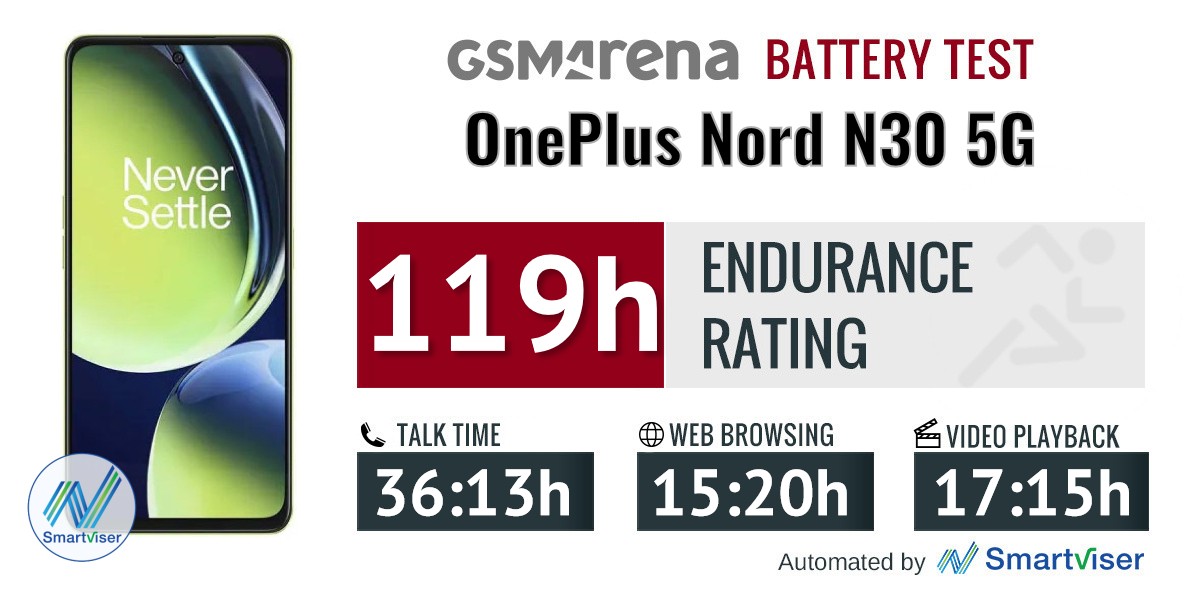
It should be noted that the browser test on the Nord N30 was done at its maximum 120Hz display refresh rate, while the video playback one was conducted at 60Hz, which is in keeping with our usual procedure.
Our battery tests were automated thanks to SmartViser, using its viSerDevice app. The endurance rating denotes how long the battery charge will last you if you use the device for an hour of telephony, web browsing, and video playback daily. More details can be found here.
Video test carried out in 60Hz refresh rate mode. Web browsing test done at the display's highest refresh rate whenever possible. Refer to the respective reviews for specifics. To adjust the endurance rating formula to match your own usage patterns check out our all-time battery test results chart where you can also find all phones we've tested.
Charging speed
The Nord N30 5G offers 50W SUPERVOOC wired fast charging for its 5,000 mAh battery. That's a bit less than the 67W the Nord CE 3 Lite offers in Europe and Asia, but also notably more than the 33W of charging the Realme 10 Pro comes with.

As mentioned, the phone ships with an overprovisioned charger with an output of 5V-11V@5A when connected to a 100-130V circuit or 5V-11V@6.1A on a 200-240V circuit.
The Nord N30 5G is a very fast charging device. We managed to get it from zero to 40% in 15 minutes and then 73% in half an hour. A full charge took us 47 minutes.
Looking at other devices in the price range, you can get yourself something with 67W fast charging. Though, the practical benefits of the higher power rating are dubious at best, according to our testing.
Speakers
The OnePlus Nord N30 5G has a pretty solid stereo speaker setup. It's a hybrid setup with an amplified earpiece doubling as the second channel. As such, you can't really expect the output to be too well-balanced, which is fine for a budget device.
On the plus side, the Nord N30 5G is pretty loud, with a VERY GOOD rating in our testing. It has a relatively clean output. We wouldn't call it crisp, but highs sound good without being screechy or distorted, even at high volumes. Mids are also good, though nothing to phone home about. Bass is pretty poor, but that's kind of expected.
Use the Playback controls to listen to the phone sample recordings (best use headphones). We measure the average loudness of the speakers in LUFS. A lower absolute value means a louder sound. A look at the frequency response chart will tell you how far off the ideal "0db" flat line is the reproduction of the bass, treble, and mid frequencies. You can add more phones to compare how they differ. The scores and ratings are not comparable with our older loudspeaker test. Learn more about how we test here.
Reader comments
- Max
- 09 Feb 2025
- 0eM
Bottom line is, I like the phone for my every day use. And that's all that matters.
- Anonymous
- 26 Jan 2025
- IhJ
The camera quality stated in the review here is better than I have on my own Nord N30. Macro photos are heavily tinged green, and low-light photos are a no-go. Maybe the QC on this model isn't great.
- IrishMike59
- 05 Nov 2024
- Ih}
It's not a Star of David... It's representative of a toothed gear wheel... SMH...
